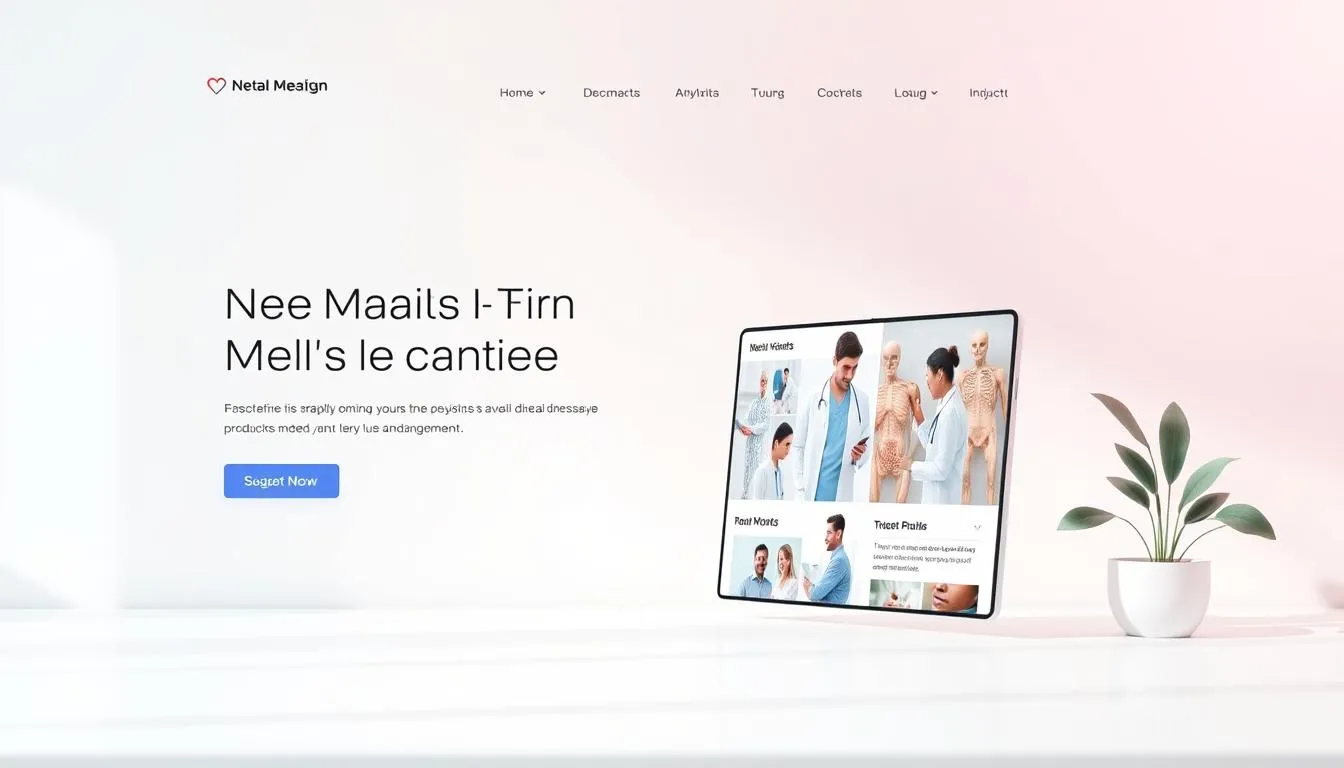Last Updated on: June 19, 2025
In today’s digital age, having a professional online presence is crucial for medical professionals. A well-designed website not only enhances credibility but also attracts new patients and fosters growth.
Effective healthcare web design is about creating a user-friendly experience that communicates your services clearly. It’s about making your medical website design stand out and reflect your practice’s values.
With the right web design for doctors, you can improve patient engagement and streamline your online operations. Discover how tailored web design services can elevate your practice.
Key Takeaways
- A professional website is essential for medical professionals.
- Effective web design enhances credibility and patient engagement.
- Tailored web design services can improve online operations.
- A well-designed website attracts new patients and fosters growth.
- User-friendly experience is crucial for a medical website.
The Digital Transformation in Healthcare
As healthcare becomes increasingly digital, the importance of a strong online presence for medical providers cannot be overstated. The way patients interact with healthcare services is changing, driven by technological advancements and the widespread use of the internet for health-related information.
Why Online Presence Matters for Medical Practices
In the digital age, patients are more likely to research healthcare providers online before making a decision. This shift in patient behavior underscores the need for medical practices to have a professional online presence.
Patient Research Behaviors in the Digital Age
Patients are now more informed than ever, with many turning to online resources to learn about medical conditions, treatments, and healthcare providers. A well-designed website can provide the information patients are seeking, establishing a practice as a trusted authority in their care.
Building Trust Through Professional Web Presence
A professional website not only provides essential information but also conveys a sense of reliability and professionalism. By investing in a quality web design, healthcare providers can build trust with potential patients, making them more likely to choose their services.
The Impact of Quality Web Design on Patient Acquisition
Quality web design plays a crucial role in patient acquisition. A website that is both informative and easy to navigate can significantly improve a practice’s ability to attract new patients.
Conversion Optimization for Healthcare Websites
Conversion optimization is key to ensuring that a website effectively turns visitors into patients. This involves designing the site with clear calls to action, intuitive navigation, and a responsive design that works across various devices.
Unique Web Design Needs for Healthcare Providers
Effective web design for healthcare providers must balance functionality with the need for secure, patient-focused online experiences. This balance is crucial in addressing the unique challenges faced by healthcare websites.
HIPAA Compliance Requirements
One of the primary concerns for healthcare web design is ensuring HIPAA compliance. This involves implementing secure data handling protocols to protect patient information.
Secure Data Handling Protocols
Healthcare websites must use encryption and secure servers to safeguard patient data. Regular security audits are also essential.
Privacy Policy Considerations
A clear and comprehensive privacy policy is mandatory, informing patients how their data is used and protected.
Patient-Centric Design Considerations
A patient-centric design focuses on creating an intuitive and accessible user experience. This includes easy navigation and clear information about services and treatments.
Accessibility Standards for Healthcare Websites
Healthcare websites must adhere to accessibility standards, ensuring that all users, including those with disabilities, can access the site.
ADA Compliance for Medical Sites
ADA compliance is critical, requiring websites to be designed in a way that is accessible to everyone, regardless of disability.
As noted by a healthcare IT expert, “A well-designed website is not just about aesthetics; it’s about creating a secure and accessible platform for patients to engage with healthcare services.” This underscores the importance of balancing design with functionality and compliance.
Essential Features for Healthcare Websites
Healthcare websites require specific features to enhance patient engagement and provide a seamless user experience. These features are crucial for modern healthcare practices aiming to improve patient satisfaction and streamline operations.
Online Appointment Scheduling Systems
One of the key features is an online appointment scheduling system, allowing patients to book appointments at their convenience. This not only improves patient satisfaction but also reduces no-show rates by sending automated reminders.
Secure Patient Portals
Secure patient portals are another essential feature, providing patients with secure access to their medical records and billing information. Within these portals, patient information management is critical, ensuring that patient data is accurately stored and easily accessible.
Patient Information Management
Effective patient information management involves organizing patient data in a way that is both secure and easily accessible to authorized personnel.
Secure Messaging Capabilities
Secure messaging capabilities within patient portals enable safe communication between patients and healthcare providers, enhancing patient engagement and reducing the need for phone calls.
Telemedicine Integration Options
With the rise of telehealth, telemedicine integration has become a vital feature for healthcare websites, allowing for virtual consultations and expanding the reach of healthcare services.
Mobile Responsiveness for On-the-Go Access
Mobile responsiveness ensures that healthcare websites are accessible and user-friendly on various devices, catering to the on-the-go lifestyle of modern patients.
Where Can Healthcare Professionals Find Web Design Services?
Healthcare professionals seeking web design services have numerous options to consider for their online presence. The key is to find a service that understands the unique needs of the healthcare industry.
Specialized Healthcare Web Design Agencies
Specialized healthcare web design agencies offer tailored solutions that cater to the specific requirements of medical practices. These agencies typically have experience with HIPAA compliance and patient-centric design.
Top Healthcare-Focused Design Firms in the US
Some of the top healthcare-focused design firms in the US include companies like Symphony Technology Group and Healthcare Source. These firms have a proven track record of creating effective healthcare websites.
Freelance Designers with Medical Industry Experience
Freelance designers with experience in the medical industry can offer personalized web design services. They often bring a fresh perspective and can be more cost-effective than larger agencies.
Platforms to Find Qualified Healthcare Designers
Platforms like Upwork and Freelancer can connect healthcare professionals with qualified freelance designers. These platforms allow for a review of portfolios and client feedback.
Web Design Platforms with Healthcare Templates
Web design platforms offering healthcare templates provide a convenient starting point for creating a healthcare website. These templates are often designed with the necessary features and compliance considerations in mind.
Customization Options for Template-Based Solutions
Many web design platforms, such as Wix and WordPress, offer customization options for their healthcare templates. This allows healthcare professionals to tailor their website to their specific needs.
Evaluating Web Design Service Providers
Selecting the right web design service provider is crucial for healthcare professionals looking to establish a strong online presence. A well-designed website can significantly impact patient engagement and acquisition.
Portfolio Assessment: Medical Website Examples
When evaluating web design service providers, one of the first steps is to assess their portfolio, particularly examples of medical websites they have designed. Look for websites that are visually appealing, easy to navigate, and provide a good user experience. A strong portfolio indicates the provider’s ability to deliver high-quality websites tailored to the healthcare industry.
Understanding Their Healthcare Industry Knowledge
It’s essential to understand the web design provider’s knowledge of the healthcare industry. This includes their familiarity with HIPAA compliance requirements and other regulatory standards. Ask about their experience working with healthcare clients and their approach to creating patient-centric designs.
Key Questions to Ask Potential Designers
When discussing your project with potential web designers, consider asking the following questions:
- Can you share examples of healthcare websites you’ve designed?
- How do you ensure HIPAA compliance in your web designs?
- What is your approach to creating a patient-centric website?
Client Testimonials from Other Medical Professionals
Client testimonials provide valuable insights into a web design provider’s reliability and quality of service. Look for testimonials from other medical professionals or healthcare organizations to gauge their satisfaction with the provider’s work.
Red Flags to Watch For When Reviewing Providers
While evaluating web design service providers, be aware of red flags such as a lack of relevant experience, poor communication, or a generic approach to web design. A reputable provider will be transparent about their process and capabilities.
Cost Considerations for Healthcare Website Development
Healthcare providers looking to establish a strong online presence need to consider the financial aspects of website development. A well-designed website is a crucial investment for medical practices, but it requires careful budget planning.
Budget Planning for Different Practice Sizes
The cost of developing a healthcare website can vary significantly based on the size and complexity of the practice. For instance, solo practitioners have different needs compared to multi-provider clinics.
Solo Practitioners vs. Multi-Provider Clinics
Solo practitioners typically require simpler website designs with basic features, while larger clinics need more complex systems with additional functionalities such as multiple user accounts and advanced appointment scheduling.
Understanding ROI for Medical Website Investments
Investing in a healthcare website can yield significant returns through increased patient acquisition and retention. A well-designed website can improve patient engagement and streamline administrative tasks.
Key benefits of a healthcare website include:
- Increased online visibility
- Improved patient communication
- Streamlined appointment scheduling
Ongoing Maintenance and Support Costs
After the initial development, ongoing maintenance and support are crucial to keep the website secure, updated, and functioning properly.
Monthly vs. Annual Service Contracts
Healthcare practices can choose between monthly or annual service contracts for maintenance and support. Annual contracts often provide cost savings, while monthly contracts offer more flexibility.
It’s essential to carefully evaluate the service provider’s offerings and choose a contract that aligns with the practice’s needs and budget.
The Healthcare Web Design Process Explained
Healthcare web design is a multi-step process that demands attention to detail and a patient-centric approach. A well-structured web design process ensures that the final product meets the needs of both healthcare providers and their patients.
Discovery and Requirements Gathering
The first stage involves understanding the healthcare provider’s needs and goals. This is achieved through stakeholder interviews and needs assessment.
Stakeholder Interviews and Needs Assessment
Conducting interviews with key stakeholders helps identify the website’s purpose, target audience, and required features. This stage is crucial for gathering requirements and creating a tailored web design plan.
Design and Development Phases
The design phase focuses on creating a visually appealing and user-friendly interface. This involves wireframing and prototyping to visualize the website’s layout and functionality.
Wireframing and Prototyping for Medical Sites
Wireframing and prototyping are essential steps in the design process, allowing healthcare providers to review and refine the website’s structure and features before development begins.
Testing and Launch Procedures
Before launching the website, thorough testing is conducted to ensure all features function correctly and the site is user-friendly.
Post-Launch Support Options
After the website is launched, ongoing support is crucial for maintaining its effectiveness and ensuring it remains up-to-date with the latest technologies and security measures.
By following this structured web design process, healthcare providers can create a website that effectively serves their patients and supports their practice’s growth.
Content Strategy for Medical Websites
Creating a content strategy for medical websites involves understanding the delicate balance between authoritative health information and marketing needs. A well-planned strategy ensures that the website not only attracts patients but also provides them with valuable and accurate health information.
Creating Authoritative Health Information
Authoritative health information is crucial for establishing trust with patients. This involves:
- Providing accurate and up-to-date medical information
- Citing credible sources
- Avoiding sensational or misleading content
Balancing Compliance with Marketing Needs
Healthcare providers must balance the need to market their services with the requirement to comply with regulations such as HIPAA. This can be achieved by:
- Focusing on patient education
- Highlighting the unique benefits of their services without compromising patient privacy
Balancing Medical Accuracy with Readability
It’s essential to present complex medical information in a way that is easy for patients to understand. This involves:
- Using clear and simple language
- Avoiding jargon
Writing for Patients vs. Colleagues
The tone and content should be tailored to the target audience. When writing for patients, the focus should be on clarity and relevance, while content for colleagues can be more technical.
Visual Content Guidelines for Healthcare Sites
Visual content can enhance the user experience and convey complex information more effectively. Guidelines include:
Appropriate Imagery for Medical Practices
Imagery should be professional and relevant to the medical practice. Examples include:
- Photos of healthcare providers
- Images of medical facilities
SEO Strategies for Healthcare Providers
For healthcare providers, a well-crafted SEO strategy is no longer a luxury, but a necessity in today’s digital healthcare ecosystem. Effective SEO helps medical practices increase their online visibility, attract more patients, and stay ahead of the competition.
Local SEO for Medical Practices
Local SEO is critical for healthcare providers as it enables them to reach patients in their immediate area. By optimizing their website and online presence for local search, medical practices can improve their chances of appearing in search results for location-based queries.
Google Business Profile Optimization
Optimizing a Google Business Profile is a fundamental step in local SEO. This involves claiming and verifying the business listing, ensuring accuracy and consistency of the practice’s name, address, and phone number (NAP), and responding promptly to patient reviews.
Medical Keyword Research Techniques
Conducting thorough keyword research is essential for developing an effective SEO strategy. Healthcare providers should identify relevant keywords and phrases that potential patients use when searching for medical services online.
Building Authority in Healthcare Search Results
Building authority in healthcare search results requires a combination of high-quality content, technical SEO, and online reputation management. By creating authoritative and informative content, healthcare providers can establish their practice as a trusted source of medical information.
Managing Online Reviews and Reputation
Managing online reviews is crucial for maintaining a positive online reputation. Healthcare providers should encourage satisfied patients to leave reviews and respond promptly to both positive and negative feedback to demonstrate their commitment to patient care.
Integrating Practice Management Systems
Integrating practice management systems is a strategic move for healthcare providers aiming to improve efficiency and patient care. By seamlessly connecting various systems, healthcare organizations can streamline their operations, reduce administrative burdens, and enhance patient satisfaction.
EHR and EMR Connectivity Options
One of the critical aspects of integrating practice management systems is ensuring connectivity with Electronic Health Records (EHR) and Electronic Medical Records (EMR). This integration enables healthcare providers to access patient information easily, make informed decisions, and provide coordinated care.
Security Considerations for System Integration
When integrating EHR and EMR systems, security is paramount. Healthcare providers must ensure that the integration complies with HIPAA regulations to protect patient data. This involves implementing robust security measures, such as encryption and secure authentication protocols.
Payment Processing Solutions
Another essential component of practice management systems is payment processing. By integrating secure payment gateways, healthcare providers can facilitate easy and secure transactions, improving the patient experience and reducing administrative tasks.
HIPAA-Compliant Payment Gateways
It is crucial to select HIPAA-compliant payment gateways to ensure that patient financial information is protected. These gateways must adhere to strict security standards to prevent data breaches and maintain patient trust.
Insurance Verification Tools
Insurance verification is a vital function of practice management systems. By integrating insurance verification tools, healthcare providers can quickly verify patient coverage, reducing the risk of claim denials and improving revenue cycle management.
Case Studies: Successful Healthcare Websites
Successful healthcare websites are now more than just a digital presence; they’re a gateway to quality care. Let’s explore some real-world examples of effective web design in healthcare.
Primary Care Practice Website Transformations
A primary care practice in New York saw a 30% increase in patient engagement after redesigning their website with a patient-centric approach. Key features included:
- Online appointment scheduling
- Patient portal for secure messaging
- Easy access to health resources
Specialist Clinic Online Presence Improvements
A specialist clinic in California revamped their website, resulting in a 25% boost in new patient acquisitions. The new design incorporated:
- Clear calls-to-action
- Detailed service descriptions
- Responsive design for mobile users
Hospital System Web Design Innovations
A large hospital system on the East Coast implemented innovative web design features, including:
- Telemedicine integration
- AI-powered symptom checker
- Personalized patient dashboards
This redesign led to improved patient satisfaction and operational efficiency.
Conclusion: Taking the Next Step in Your Digital Healthcare Journey
As a healthcare professional, establishing a strong online presence is crucial for attracting and retaining patients. By understanding the unique web design needs of your practice, you can create a website that effectively communicates your services and values.
By incorporating essential features such as online appointment scheduling, secure patient portals, and telemedicine integration, you can enhance the patient experience and streamline your operations. A well-designed website can also improve your search engine rankings, driving more traffic to your site.
Now that you’ve learned about the importance of web design in healthcare, it’s time to take the next steps in your digital healthcare journey. Consider partnering with a specialized web design agency or exploring web design platforms with healthcare templates to find the best solution for your practice.
By taking control of your online presence, you can improve patient engagement, increase conversions, and drive growth for your practice. Start your digital healthcare journey today and discover the benefits of a well-designed website for your patients and your practice.
FAQ
What are the key considerations for healthcare website design?
When designing a healthcare website, key considerations include HIPAA compliance, patient-centric design, and accessibility standards to ensure a professional and trustworthy online presence.
How can healthcare websites improve patient engagement?
Healthcare websites can improve patient engagement by incorporating features such as online appointment scheduling, secure patient portals, and telemedicine integration, making it easier for patients to interact with the practice.
What is the importance of mobile responsiveness for healthcare websites?
Mobile responsiveness is crucial for healthcare websites as it ensures that patients can access the site and its features on-the-go, using their smartphones or tablets, thus enhancing the overall user experience.
How can healthcare providers ensure HIPAA compliance for their website?
To ensure HIPAA compliance, healthcare providers should implement secure data handling protocols, include privacy policy considerations, and use HIPAA-compliant payment gateways for any online transactions.
What are the benefits of integrating practice management systems with healthcare websites?
Integrating practice management systems with healthcare websites can streamline operations by enabling EHR and EMR connectivity, payment processing solutions, and insurance verification tools, thus improving efficiency and reducing administrative burdens.
How can healthcare websites be optimized for search engines?
Healthcare websites can be optimized for search engines through local SEO techniques, medical keyword research, and building authority in healthcare search results, which helps in managing online reputation and improving visibility.
What should healthcare professionals look for when evaluating web design service providers?
When evaluating web design service providers, healthcare professionals should assess their portfolio, understand their healthcare industry knowledge, and review client testimonials to ensure they find a provider that meets their needs.
What are the cost considerations for developing a healthcare website?
Cost considerations for developing a healthcare website include budget planning for different practice sizes, understanding the return on investment (ROI), and considering ongoing maintenance and support costs.




